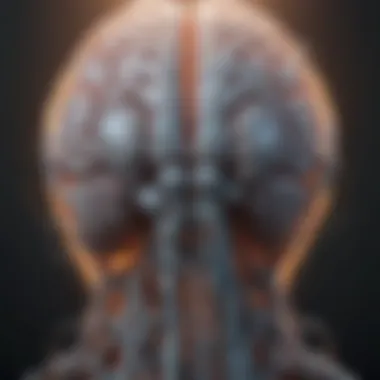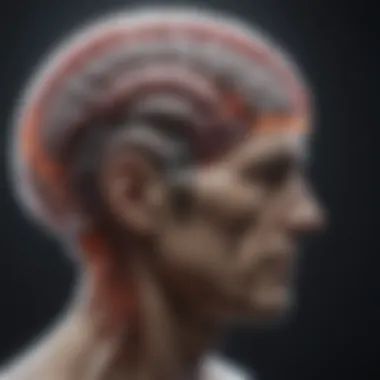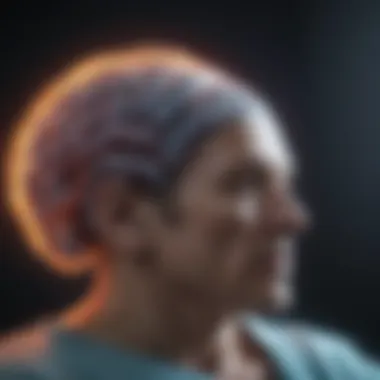What Can an MRI of the Brain Detect?


Research Overview
Magnetic Resonance Imaging (MRI) has become a vital method for exploring the human brain's complexities. This imaging technique utilizes powerful magnets and radio waves to create detailed images of brain structures. The findings from MRI scans can indicate various conditions, shedding light on abnormalities or changes within the brain.
Summary of Key Findings
Research shows that MRI scans can detect a range of brain abnormalities. Common findings include brain tumors, which may present as well-defined masses or infiltrative lesions. Vascular conditions, such as strokes and aneurysms, are also identifiable through MRI. Additionally, neurodegenerative diseases like Alzheimer’s disease can reveal atrophy in specific brain regions. Findings can vary based on the MRI technique employed, such as functional MRI (fMRI) that assesses brain activity by detecting changes in blood flow.
- Brain tumors are detected in various forms, such as metastatic lesions or primary brain tumors.
- Vascular issues include conditions like ischemic strokes, hemorrhagic strokes, and arteriovenous malformations.
- Neurodegenerative diseases often show characteristic patterns of brain shrinkage.
- Multiple Sclerosis can be observed through lesions scattered throughout the white matter.
Importance of the Research
Understanding what MRI can detect is crucial for medical professionals. The insights gained from MRI scans help in formulating effective treatment plans. Knowledge of brain abnormalities can expedite intervention and improve patient prognosis. This tool not only aids in diagnosis but also plays a significant role in ongoing research related to neurological health.
Methodology
MRI technology continuously evolves, leading to improved diagnostic capabilities. The combinations of different protocols and sequences yield varied results that enhance the understanding of neurological issues.
Study Design
MRI studies utilize a range of designs from cross-sectional to longitudinal studies. The choice of design can influence the data obtained and its interpretation. For instance, longitudinal studies allow tracking of disease progression, while cross-sectional studies provide a snapshot of brain health at a given time.
Data Collection Techniques
Data collection involves obtaining MRI scans using various sequences like T1-weighted, T2-weighted, and diffusion-weighted imaging. These sequences provide different perspectives on brain structure and function. Clinicians analyze the resulting images for abnormalities and assess the underlying conditions.
The precision of MRI technology offers unparalleled insights into brain health, making it an essential tool for clinicians and researchers alike.
Foreword to MRI Technology
Magnetic Resonance Imaging, commonly referred to as MRI, plays a pivotal role in neuroimaging by offering detailed insight into brain health. Understanding MRI technology is essential for professionals aiming to utilize it effectively in clinical settings. This section will outline how MRI operates, the principles behind its imaging capabilities, and its advantages over other imaging techniques.
Overview of Magnetic Resonance Imaging
MRI stands out among diagnostic tools due to its non-invasive nature and ability to produce high-resolution images. Unlike X-rays or CT scans, MRI uses strong magnets and radio frequencies to generate images without exposure to ionizing radiation. This characteristic makes MRI particularly valuable, especially for patients who require repeated imaging.
MRI also enables clinicians to observe both structural and functional aspects of the brain, providing a more comprehensive picture of neurological health. The clarity of these images assists in diagnosing various conditions, from tumors to degenerative diseases.
In summary, the overview of MRI technology emphasizes its significance as a superior tool in brain diagnostics.
Principles of MRI Operation
Understanding how MRI works involves examining two fundamental principles: Magnetic Field Generation and Nuclear Magnetic Resonance. These principles are the backbone of MRI technology and contribute significantly to its functionality in medical imaging.
Magnetic Field Generation
The process begins with Magnetic Field Generation, which utilizes powerful magnets to create a strong and stable magnetic field. This field is essential for aligning the protons in the body's hydrogen atoms, particularly those in water molecules, which are abundant in biological tissues.
One key characteristic of this magnetic field is its ability to produce uniformity across the imaging area, resulting in clearer and more precise images. The benefit of using a magnetic field in MRI is that it is safe and does not expose the patient to harmful radiation.
A unique feature of Magnetic Field Generation is its capability to provide different levels of detail depending on the strength of the magnetic field. High-field MRIs, for example, can produce more detailed images compared to low-field systems, making them beneficial for intricate evaluations of brain conditions.
Nuclear Magnetic Resonance


Nuclear Magnetic Resonance (NMR) is the second principle that allows MRI to function effectively. After the magnetic field is applied, radiofrequency pulses are transmitted to the area under examination. NMR enables the detection of signals emitted from the protons as they return to their original state after the radiofrequency pulse is removed.
The key characteristic of NMR lies in its sensitivity to the chemical environment around the hydrogen atoms, which aids in differentiating between various types of tissues. This quality makes NMR a beneficial factor in MRI, particularly for identifying abnormalities in brain tissue.
A unique advantage of Nuclear Magnetic Resonance is its ability to yield insights into the metabolic state of tissues, which can help in determining the presence of diseases at a molecular level. However, a disadvantage to be aware of is that the process can be time-consuming and may require careful calibration to produce optimal results.
In summary, understanding the principles of MRI operation helps highlight its advantages in accurately detecting various brain conditions, making it an essential tool in modern neurology.
Structural Brain Imaging
Structural brain imaging plays a crucial role in the field of neuroimaging. This imaging technique allows practitioners to visualize the anatomical details of the brain with remarkable clarity. Structural MRI provides detailed images that can help in the diagnosis of various neurological conditions. With the application of structural imaging, clinicians can assess brain anatomy, detect abnormalities, and monitor various pathologies over time, making it a fundamental aspect of neuroimaging.
Evaluation of Brain Anatomy
Cortex and Subcortical Structures
The cortex and subcortical structures are vital components of the brain that an MRI can effectively evaluate. The cortex is the outermost layer of the brain, responsible for higher-level functions like thinking, perception, and motor control. Subcortical structures, which lie beneath the cortex, include important areas such as the thalamus and basal ganglia, which play roles in sensory processing and movement regulation.
Understanding the cortex and subcortical structures is essential for diagnosing disorders affecting cognition and motor functions. Their detailed representation in MRI scans assists healthcare professionals in identifying potential issues, such as damage from traumatic brain injuries or degenerative diseases, making these structures a focal point in the study of brain health.
A unique advantage of imaging these areas with MRI is the distinction it provides between different types of brain tissue. This allows for better delineation of lesions or abnormalities compared to other imaging methods. However, interpreting the scans can be complex and requires a skilled radiologist and clinician team to provide a thorough analysis.
Cerebellum and Brainstem
The cerebellum and brainstem also hold significant importance when evaluating brain anatomy via MRI. The cerebellum plays a critical role in coordinating movement and balance, while the brainstem controls many vital functions, including heart rate and breathing.
Imaging these structures is beneficial for diagnosing certain neurological conditions, such as ataxias and brainstem strokes. Their clear depiction provides valuable information for treatment decisions and understanding the underlying causes of certain symptoms.
One of the unique features of MRI in assessing the cerebellum and brainstem is its ability to visualize subtle changes in these areas over time. This capacity is particularly useful in monitoring the progression of diseases like multiple sclerosis, where lesions may develop in these regions. Despite the advantages, the close proximity of these structures to other critical areas can sometimes complicate imaging interpretation, requiring careful analysis.
Detection of Abnormalities
Lesions and Tumors
Lesions and tumors are significant findings that MRI can detect within the brain. Lesions can be due to a range of factors including trauma, infection, or neurodegenerative diseases. Tumors, whether benign or malignant, necessitate accurate and timely detection as they impact critical treatment decisions.
MRI provides high-resolution images that reveal the size, shape, and location of lesions and tumors effectively. This feature makes it a popular method for neuro-oncology assessments. Different MRI sequences can enhance the visibility of tumors against normal brain tissue.
However, while MRI is a preferred option, differential diagnosis remains a challenge. Certain characteristics may overlap between lesions and tumors, and a comprehensive evaluation often requires additional imaging and clinical correlation.
Cysts and Hydrocephalus
Cysts and hydrocephalus are other abnormalities that can be detected using MRI. Cysts are fluid-filled sacs that may or may not present symptoms. Hydrocephalus, characterized by an excess accumulation of cerebrospinal fluid in the brain, can lead to increased intracranial pressure.
MRI is particularly adept at visualizing the presence and extent of these conditions, providing clear images of the ventricles and surrounding tissue. For hydrocephalus, the ability to measure ventricle size is critical for assessing the severity and planning treatment options.
A notable feature of MRI in this context is its non-invasive nature, allowing for repeated imaging without the risks that accompany other diagnostic methods, such as invasive procedures. Nonetheless, interpreting MRI results in the context of cysts can be challenging, as many individuals can have incidental findings that do not necessitate intervention.
Functional MRI Applications
Functional MRI (fMRI) represents a pivotal advancement in neuroimaging, offering insights not only into brain structure but also into brain activity. The ability to visualize how different areas of the brain respond during various tasks enables researchers and clinicians to explore cognitive functions and identify disorders. This section will address the two primary approaches of fMRI: task-based and resting-state imaging. Each method unveils distinct patterns of brain activity and serves diverse purposes in both research and clinical settings.
Mapping Brain Activity
Mapping brain activity through fMRI is instrumental in understanding how the brain processes information. It informs us about functional connectivity—the way different brain regions communicate with each other—illuminating the intricate networks that contribute to cognitive functions, emotions, and behaviors. It also aids in identifying neural pathways affected by various conditions; this is crucial in developing targeted therapies.


Task-Based fMRI
Task-based fMRI specifically measures brain reactivity in response to externally defined tasks. By engaging subjects in cognitive activities, researchers can monitor changes in blood flow to particular regions of the brain. This characteristic is particularly important as it directly demonstrates which areas are activated during specific tasks, such as problem-solving or language processing.
The unique feature of task-based fMRI is its high temporal resolution, which allows researchers to observe brain activation in real time. This aspect makes it a popular choice for cognitive neuroscience studies seeking to associate specific tasks with brain regions. However, one limitation is that these tasks may not replicate naturalistic conditions, potentially skewing results in some contexts.
Resting-State fMRI
Resting-state fMRI offers a more holistic view of brain function. It observes the brain while a subject is not actively engaged in any specific task, thus capturing spontaneous brain activity. This approach is significant as it allows for the identification of intrinsic functional networks, elucidating how different areas interact even in a resting state.
One of the key characteristics of resting-state fMRI is its capacity to trace the default mode network, which is active when the brain is at rest but silent during focused tasks. This aspect increases its relevance in understanding conditions like Alzheimer's disease or depression, where connectivity disruptions are present.
However, the interpretation of resting-state data can be complex due to variability among individuals, which may complicate comparisons across populations.
Clinical Implications of Functional MRI
The clinical implications of fMRI are profound. Enhanced understanding of brain function facilitates more accurate diagnoses of neurological disorders, assists in pre-surgical planning, and guides rehabilitation strategies. fMRI is also invaluable in the research arena, contributing to the development of new therapies and improving our comprehension of cognitive processes.
Overall, functional MRI plays a critical role in advancing neuroimaging and enhancing our grasp of the brain's complex dynamics.
The ability to visualize brain activity offers a window into the underlying mechanisms of various conditions. This understanding can lead to improved treatment and, ultimately, better patient outcomes.
Neurological Disorders
Understanding neurological disorders is critical in comprehending the vast landscape of brain health. These conditions can have significant implications for individuals, affecting their cognitive, emotional, and physical well-being. An MRI of the brain is a valuable tool in diagnosing these disorders, providing detailed images that help in identifying abnormalities related to both structure and function. This section will delve into different neurological disorders, emphasizing the role of MRI in their detection and management.
Identifying Tumors
Types of Brain Tumors
Brain tumors can be classified into two main types: primary and secondary. Primary tumors originate in the brain tissue itself, while secondary tumors arise from cancer spreading from other parts of the body. The significance of identifying these tumors cannot be overstated. MRI scans excel in visualizing these masses, enabling healthcare providers to distinguish between various types of tumors.
Meningiomas, gliomas, and pituitary tumors are among the most common types. The unique feature of gliomas, for example, is their location and type of cells involved, which can profoundly affect treatment strategies. Understanding the distinction between these tumor types through MRI can lead to better-targeted therapies.
However, there are challenges. Some tumors may be difficult to differentiate on scans alone, necessitating biopsies for conclusive identification. Despite this, MRI remains a crucial part of the diagnostic journey for those with suspected brain tumors.
Metastatic Disease
Metastatic disease occurs when cancer cells spread to the brain from other parts of the body. It is one of the most common forms of brain cancer in adults. Detecting metastatic lesions via MRI is highly beneficial because it allows for early intervention, which can significantly improve patient outcomes.
The key characteristic of metastatic brain lesions is their varied appearance and location. They often present as multiple lesions, making MRI an invaluable resource for identifying their presence. The unique attribute of MRI is its capacity to provide high-resolution images that can illustrate not just the tumors but also the surrounding brain structures, aiding in treatment planning.
Yet, diagnosing metastatic disease is not without its complications. The imaging might sometimes reveal non-cancerous lesions that mimic the appearance of metastatic tumors, leading to unnecessary anxiety. Nonetheless, MRI remains an essential tool in identifying and managing metastatic disease.
Assessing Stroke and Vascular Issues
Ischemic Stroke Detection
Ischemic stroke occurs when blood flow to a part of the brain is obstructed, leading to potential brain damage. Detecting an ischemic stroke swiftly is crucial because timely intervention can reduce the risk of permanent damage. MRI is particularly effective in identifying areas of reduced blood flow and assessing the extent of damage.
The main advantage of MRI in this context is its ability to visualize not just the blood vessels but also the brain tissue. Unique to MRI is the diffusion-weighted imaging technique, which can highlight areas of the brain that suffer from ischemia even within a few hours of the event, greatly enhancing diagnostic capabilities.
However, the availability of this technology can sometimes be limited in emergency settings, where rapid decisions are vital. Despite this, the clarity it provides is often paramount for long-term outcomes.
Hemorrhagic Stroke Imaging


In contrast to ischemic stroke, hemorrhagic stroke involves bleeding within the brain. This condition can be life-threatening, making rapid and accurate diagnosis essential. MRI can play a key role by identifying the location and extent of bleeding, which is critical for treatment planning.
The characteristic feature of hemorrhagic stroke is the immediate change in brain appearance on the MRI, showing regions of high signal intensity that indicate hemorrhage. This allows medical professionals to assess the severity of the stroke and the potential need for surgical intervention.
Nonetheless, there are limitations. In cases of chronic hemorrhage, MRI may not provide as clear a picture as other imaging methods like CT scans. Yet, for acute situations, MRI remains a powerful ally in effective medical response.
Neurodegenerative Diseases
Alzheimer's Disease
Alzheimer's disease is a progressive neurodegenerative disorder that affects memory, thinking, and behavior. The role of MRI in diagnosing Alzheimer's is pivotal, particularly in detecting early changes in brain structure associated with the disease. MRI can visualize the atrophy of specific brain regions, such as the hippocampus, which are often affected in Alzheimer's patients.
Its advantage lies in the ability to provide detailed images that can highlight these subtle changes, which can be crucial for early intervention. However, it is important to note that MRI cannot diagnose Alzheimer's conclusively; rather, it must be used in conjunction with other diagnostic tools.
Multiple Sclerosis
Multiple sclerosis (MS) is another neurodegenerative condition that MRI effectively detects. It is characterized by the formation of lesions in the central nervous system. MRI is indispensable in identifying these lesions, particularly in the white matter of the brain.
The uniqueness of MRI in this context is its capability to visualize the number, size, and distribution of lesions, providing essential information for treatment planning. This makes MRI a standard procedure for monitoring disease progression in individuals with MS. Nonetheless, misinterpretation of benign lesions as active MS lesions can lead to unnecessary anxiety. Hence, while MRI is a valuable tool, clinicians must integrate clinical evaluations and other tests in the assessment process.
Advanced MRI Techniques
Advanced MRI techniques represent a significant leap in neuroimaging. They have enabled researchers and clinicians to observe the brain's structure and function with greater clarity. Specifically, techniques like Diffusion Tensor Imaging (DTI) and Magnetic Resonance Spectroscopy (MRS) provide unique insights into brain connectivity and metabolic processes. The ability to assess white matter integrity and chemical composition allows for better understanding of various neurological conditions. This section highlights these advanced methods and their clinical relevance.
Diffusion Tensor Imaging
Understanding White Matter Integrity
Diffusion Tensor Imaging is crucial for assessing white matter integrity in the brain. It provides detailed information about the directionality of water movement within brain tissues. This characteristic is vital as it helps map neural pathways, offering insights into how different brain areas communicate. The unique feature of DTI is its ability to visualize the organization of white matter fibers. This is beneficial because it can detect subtle changes that might not be visible in traditional MRI scans. A drawback of DTI, however, is its sensitivity to motion artifacts, which can affect the quality of the images obtained in some patients.
Applications in Neurology
The applications of Diffusion Tensor Imaging in neurology are extensive. It plays a critical role in understanding various neurological disorders, such as multiple sclerosis and traumatic brain injuries. A key characteristic of DTI is its utility in pre-surgical planning, allowing surgeons to avoid critical fiber tracts during operations. Its unique capacity to show real-time changes in brain microstructure is beneficial for tracking disease progression. Nonetheless, while DTI offers significant insights, its complexity and the requirement for specialized interpretation can limit its widespread use.
Magnetic Resonance Spectroscopy
Metabolic Profiling of Brain Tissue
Magnetic Resonance Spectroscopy is a powerful tool for metabolic profiling of brain tissue. It helps identify and quantify specific metabolites, offering insights into the biochemical state of the brain. A key characteristic of MRS is its ability to detect abnormal metabolite concentrations associated with various diseases, including tumors and neurodegenerative disorders. The unique feature that sets MRS apart is its non-invasive nature, providing metabolic insights without the need for biopsies. However, MRS has limitations in spatial resolution, making it challenging to localize specific metabolic changes precisely.
Identifying Biochemical Changes
Identifying biochemical changes in the brain through Magnetic Resonance Spectroscopy is vital for diagnosing and monitoring diseases. This technique enables clinicians to observe fluctuations in neurotransmitters, which can correlate with conditions like depression or schizophrenia. A key characteristic of identifying biochemical changes is that it can enhance the understanding of disease mechanisms, supporting the development of targeted therapies. The unique feature of MRS is its potential to guide clinical decisions by providing a biochemical context to the clinical symptoms observed. Nonetheless, like DTI, MRS requires careful interpretation and can be influenced by physiological variations, which may complicate the analysis of the results.
Advanced MRI techniques are reshaping the way we understand brain health. By providing detailed insights, these methods open new avenues for research and clinical practice.
In summary, advanced MRI techniques, including Diffusion Tensor Imaging and Magnetic Resonance Spectroscopy, enhance the detection and understanding of various neurological conditions. Their unique features and applications contribute significantly to the overall goal of improving patient care and outcomes.
Ending
The discussion about what an MRI of the brain can detect underscores the vital role this imaging technology plays in modern medicine. With the ability to visualize neural structures and monitor functional activity, MRI stands as a cornerstone in diagnosing a range of neurological conditions. Its precision in identifying tumors, vascular issues, and neurodegenerative diseases is unmatched, making it indispensable for patient care.
The Future of Brain MRI
As advancements in MRI technology continue, the future holds promising developments. Innovations like higher-field strength MRI machines are likely to enhance image resolution, providing even clearer insights into brain structures. Moreover, integrating AI algorithms with MRI scans can streamline diagnosis and improve accuracy. This could lead to earlier detection of conditions and personalized treatment plans tailored to individual patients.
Furthermore, ongoing research into new contrast agents may allow for better visualization of certain abnormalities, enhancing the diagnostic capabilities of MRI.
Implications for Patient Care
The implications of MRI findings extend beyond mere diagnoses. They can direct treatment decisions, predict disease progression, and assess treatment response. Clinicians rely on MRI not just for initial assessments, but also for ongoing monitoring. This makes it an integral part of comprehensive patient management strategies in neurology.



